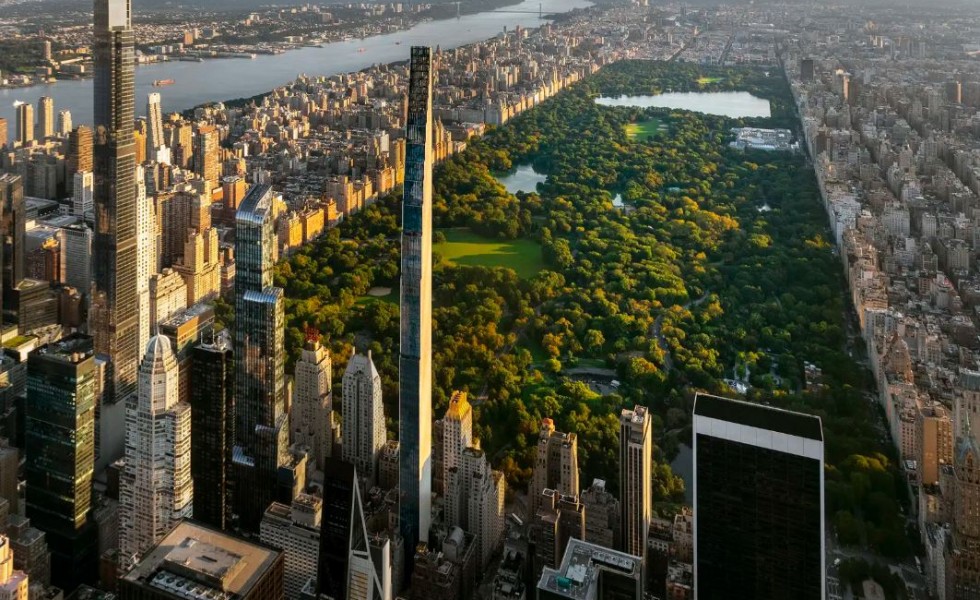The World’s Thinnest Skyscraper: Steinway Tower
23/10/24
Rome wasn't built in a day, and neither were skyscrapers. Discover how engineers and architects built the world's skinniest building.
Architects create a unique identity through every building they design. While there are other added responsibilities along with this goal, an architect uniquely solves every design problem. Skyscraper design is a combination of complex engineering systems with efficient architectural concepts. It involves tedious cycles of construction timelines and requires a hefty scale of investments. Apart from these challenges, creating a masterpiece, especially 111 West 57th Street, also known as Steinway Tower, is a rewarding journey.
This luxurious skyscraper is an original SHoP Architects structure that stands tall as the world's skinniest building.
The Story Behind the Steinway Tower
It was designed by Warren & Wetmore, an established architect of that time, for a piano company in the early 20th century. Their portfolio focused majorly on designing the Beaux-Arts style and enhancing the architectural style of the Grand Central.
The historic building was engulfed with an elegant limestone facade, grand proportions and intricate carvings, evoking a sense of timeless sophistication. The building housed piano showrooms, a 240-seat recital hall, and piano manufacturing areas, making it both functional and artistic. In 2001 and 2013, the City designated this significant building's interior and facade as landmarks because of its remarkable architectural features.
Architectural Vision and Design
Deriving its name from the iconic Steinway & Sons piano company, the high-rise tower is an exemplification of skyscraper construction. It shows a practical solution of how to seamlessly integrate a historic structure into a contemporary design. In addition to being one of the world's thinnest skyscrapers, the building's width-to-height ratio is about 1:24, making it one of the most remarkable architectural feats.
The tower features a feathered profile in contraction to the typical stepped design allowed by Midtown Manhattan's zoning bylaws. By multiplying the required setbacks, this distinctive shape gives the structure a more dynamic and sculptural appearance. The setbacks also serve as spaces for finials, which crown each terra-cotta column that rises along the east and west façades. These vertical elements add to the tower's elegant form and link it to New York's architectural legacy.
Dana Getman, SHoP Architect's associate principal, quotes, "We worked with the Landmarks Preservation Commission to relocate the tower further back on the site. It's really set back so you don't really perceive it from the street, and instead we've created a very open atrium that frees the landmark building to be read in its historic context."
Engineering Marvel
The decision to preserve the historic site enhanced the tower's design aim. Aesthetic features like articulation and vertical lines also highlight the tower's height by drawing our focus higher. The intricate decoration on the building's facade, especially the bronze accents, is reminiscent of the wealth of old New York skyscrapers. Living in a high-rise apartment may be a spine-tingling experience, aside from the amazing views of the city and the amazing engineering of the building. It took sophisticated technical techniques to keep such a tiny structure stable, especially against wind and seismic pressures.
Together, engineers and architects overcame the difficulties of building a thin skyscraper that could endure strong winds without compromising its architectural vision. Two enormous shear walls that traverse the length of the building's east and west elevations help to control the tower's height and slenderness. These walls give the building the necessary rigidity so that residents can enjoy unhindered panoramic vistas.
Residents are kept comfortable by a tuned mass damper at the top of the building, which lessens wind-induced sway. For extremely thin towers where movement can be more obvious, this technology is essential. Terracotta and bronze pilasters with 23 distinct shapes adorn the building's façade, producing a dramatic interplay of light and shadow. Inspired by classic New York skyscrapers, this intricate detailing blends tradition and modernity.
Comparison to Global Slender Skyscrapers
New York is a vibrant city that leads the world in inventions. There is an interesting fact about New York's skyscrapers: many of them were built with narrow dimensions due to pre-war zoning laws and requirements for natural light and ventilation. In an attempt to maximize light and airflow, architects created buildings with shorter footprints, stepped setbacks, and slender forms before air conditioning became widely used. This developed the traditional New York silhouette of elegant spires and tapers that defined pre-war skyscrapers such as the Empire State Building and the Chrysler Building.
Currently, ultra-thin skyscrapers such as the Steinway Tower are bringing back these dimensions for high-end residential developments. Modern engineering has made it possible for these structures to reach previously unheard-of heights while yet having incredibly thin bases, returning the old New York architectural language in a futuristic form. Given this, modern high-rise buildings in the city simultaneously pay homage to the past and showcase fresh ideas for skyscraper architecture.
How does the Steinway Tower influence future high-rise architecture?
It is an instinct that unless we build or execute something, we are not aware of the consequences. It is similar to how architects and designers didn't fully appreciate the challenges of living in a tall and slender building like the Steinway Tower. With greater innovation comes extra challenges such as cost, exclusivity, limited floor space and vertical living experience.
Taking these cues in mind, a few ways to make these towers more accessible in the future include:
- The tower might be more approachable to a wider range of people if it included a mix of cheap housing units; however, this would need zoning incentives and design changes.
- Enhancing the inclusivity of such towers and making them more welcoming to a wider audience could be accomplished by incorporating community-focused spaces and facilities, such as shared recreational areas, accessible observation decks, or public gardens.
- The building would be more suited for a larger range of users if it complied with universal design requirements for accessibility, which include wider doorways, step-free access, and adaptable interior layouts for those with impairments or mobility concerns.

